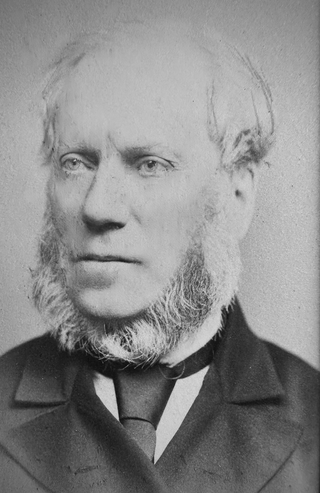
James Syme was a Scottish pioneering surgeon.

Colin Lauder, Worlds End Close, Edinburgh) was a fellow of the Royal College of Surgeons of Edinburgh FRCSEd, and a burgess of Edinburgh. His portrait was painted by Sir Henry Raeburn.

James Begbie was a Scottish medical doctor who served as president of the Medico-Chirurgical Society of Edinburgh (1850–2) and as president of the Royal College of Physicians of Edinburgh (1854–6).
Professor Andrew Fyfe FRSE FRCSE PRSSA PRMS was a Scottish surgeon and chemist. Following early studies on Fox Talbot's newly created photographic techniques he was one of the first (1839) to work out the theory behind positive rather than negative prints. He had an amateur interest in photography but appears not to have pursued his own theories and limited his experiments to ferns lying on chemical papers.

Thomas Annandale, FRCS FRSE (1838–1907) was a Scottish surgeon who conducted the first repair of the meniscus and the first successful removal of an acoustic neuroma, and introduced the pre-peritoneal approach to inguinal hernia repair. He served as Regius Professor of Clinical Surgery at the University of Edinburgh. His collection of anatomical specimens was donated to the Surgeon's Hall in Edinburgh and is now known as the Thomas Annandale Collection.

James Miller FRCSEd, FRSE was a surgeon and medical author in Edinburgh. He was author of the important 19th century textbook, Principles of Surgery. Like his father he became a member of the Free Church of Scotland in 1843 and was a firm believer in temperance.

James Scarth Combe FRSE, FRCSEd (1796–1883) was a British surgeon. He was the first person to give an accurate description of pernicious anaemia and to recognise that atrophic gastritis was a feature of the condition. He was elected a Fellow of the Royal Society of Edinburgh in 1850 and served as President of the Royal College of Surgeons of Edinburgh in 1851–52.

Dr James Dunsmure FRSE FRCSEd was a Scottish surgeon. He served as President of the Royal College of Surgeons of Edinburgh.
Dr William Farquharson FRSE PRCSE FRCPE FSAS (1760-1823) was a senior Scottish surgeon during the Scottish Enlightenment. He served as President of the Royal College of Surgeons of Edinburgh 1806-8 and President of the Harveian Society of Edinburgh in both 1796 and 1805.

Robert Alexander Fleming FRSE (1862-1947) was a Scottish pathologist and medical author who served as President of the Royal College of Physicians of Edinburgh 1927–29.

Peter David Handyside FRSE FRCSE (1808–1881) was a Scottish surgeon and anatomist. He was president of the Royal Medical Society in 1828. He won the Harveian Society Medal in 1827. He was also president of the Medico-Chirurgical Society of Edinburgh in 1871.
Dr Andrew Fergus Hewat FRSE was a Scottish physician involved with mental health. He donated the Fergus Hewat Cup to the Royal College of Physicians of Edinburgh, an annual golf championship. This is played between the Royal College of Physicians and Surgeons of Glasgow, and a combined team from the Royal College of Physicians of Edinburgh and the Royal College of Surgeons of Edinburgh.

Sir William Newbigging FRSE FRCSEd FRGS was a Scottish surgeon who served as President of the Royal College of Surgeons of Edinburgh from 1814 to 1816. He was a keen amateur geographer.
Dr George Augustus Borthwick FRSE FRCSE FSA (1784-1844) was a Scottish physician and surgeon. He was Physician to the Royal Dispensary in Edinburgh and helped to establish the Edinburgh Eye Dispensary.

Andrew Wood MD FRCSEd FRSE LLD was a 19th-century Scottish surgeon who served as President of the Royal College of Surgeons of Edinburgh from 1855 to 1857.

William Wood FRCSEd FRSE was a 19th-century Scottish surgeon who twice served as President of the Royal College of Surgeons of Edinburgh, twice as President of the Medico-Chirurgical Society and once as President of the Harveian Society.

Robert Omond, MD FRCSEd (1806–1881) was a 19th-century Scottish surgeon who served as president of the Royal College of Surgeons of Edinburgh 1857 to 1859.

Francis Darby Boyd CB CMG FRCPEd was a Scottish physician, and Professor of Clinical Medicine at the University of Edinburgh.

John Campbell was a Scottish surgeon. He served as president of the Royal College of Surgeons of Edinburgh from 1832 to 1834. In that capacity he was the last president of the College to sit ex officio as a member of the Edinburgh Town Council, so ending a tradition dating from 1583. During his presidency the College made the most significant change of location in its history, moving from Old Surgeons Hall in Surgeons' Square to the present Playfair building in Nicolson Street.

James Simson, FRCSEd was a Scottish surgeon, who worked for most of his career at the New Town Dispensary and was surgeon to the Edinburgh prison. He was president of the Royal College of Surgeons of Edinburgh from 1844-45 and again in 1873.

















